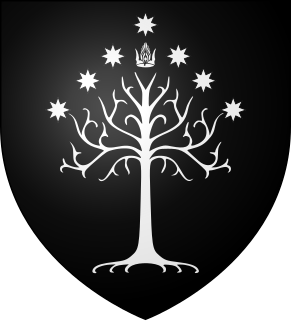In J. R. R. Tolkien's Middle-earth fiction, such as The Hobbit and The Lord of the Rings, the terms Man and Men refer to humankind – in contrast to Elves, Dwarves, Orcs, and other humanoid races – and does not denote gender. Hobbits were a branch of the lineage of Men.
Anárion is a fictional character in J. R. R. Tolkien's Middle-earth legendarium. His name is derived from Anar, which means "Sun" in Tolkien's invented language of Quenya. He was the son of Elendil and the brother of Isildur, and with them established the Realms in Exile in Middle-earth after the downfall of Númenor.
Pelendur is a fictional character in J. R. R. Tolkien's Lord of the Rings, appearing The Return of the King.

According to J. R. R. Tolkien's legendarium of Middle-earth, the Stewards of Gondor – also styled the Lords of Minas Tirith – were lords of the fictional kingdom of Gondor, who resided in Minas Tirith, the capital city. The Steward was appointed by the King, and could act on behalf of the King when the King was absent from the city or incapacitated.
This article includes several chronologies relating to J. R. R. Tolkien's legendarium.
The Reunited Kingdom of Arnor and Gondor is a fictional realm from J. R. R. Tolkien's Middle-earth.
In J.R.R. Tolkien's Middle-earth legendarium, Malbeth the Seer was a sage of Arthedain who was remembered for two prophecies.
In the literary works of J. R. R. Tolkien the House of Anárion was the Royal House of Gondor, descended from Anárion, joint first King of Gondor with his elder brother Isildur who went north to Arnor. When the last King of Gondor died without an heir, the Stewards of the House of Húrin ruled in their stead for the next 969 years until the House of Elendil successfully reclaimed the Throne after the War of the Ring.
In the literary works of J. R. R. Tolkien, the House of Isildur was the Royal House of Arnor, Arthedain, Cardolan, Rhudaur and, much later, Gondor. The house was descended from Isildur, elder son and heir of Elendil the Faithful. Although the North-Kingdom was ended in the year 1975 of the Third Age, the House of Isildur was maintained as the Chieftains of the Dúnedain, the wandering folk that the Dúnedain of Arnor became, until the time of Aragorn II and the War of the Ring, after which, Aragorn claimed the Crown of Gondor as the direct descendant of Elendil. After Aragorn, the House of Isildur became the House of Telcontar and ruled the Reunited Kingdom for generations.
It was the pride and wonder of the Northern Line that, though their power departed and their people dwindled, through all the many generations the succession was unbroken from father to son. ... But in Aragorn the dignity of the kings of old was restored
In J.R.R. Tolkien's Middle-earth, the High Kings of Arnor and Gondor were the Kings of all Dúnedain in Middle-earth after the Downfall of Númenor. Elendil was the leader of the Elendili who survived the Downfall. He claimed the title of High King.
J. R. R. Tolkien adopted the term Northmen in his fiction; his "Northmen" were Men that lived in northern Wilderland in Middle-earth, and were friendly to Gondor.
In J. R. R. Tolkien's legendarium, the Dúnedain were a race of Men descended from the Númenóreans who survived the sinking of their island kingdom and came to Eriador in Middle-earth, led by Elendil and his sons, Isildur and Anárion. They are also called the Men of the West and the Men of Westernesse. They settled mainly in Arnor and Gondor.
Aragorn II, son of Arathorn is a fictional character from J. R. R. Tolkien's legendarium. He is one of the main protagonists of The Lord of the Rings. Aragorn was a Ranger of the North, first introduced with the name Strider at Bree, as the Hobbits continued to call him throughout The Lord of the Rings. He was eventually revealed to be the heir of Isildur and rightful claimant to the thrones of Arnor and Gondor. He was also a confidant of Gandalf and an integral part of the quest to destroy the One Ring and defeat the Dark Lord Sauron.







